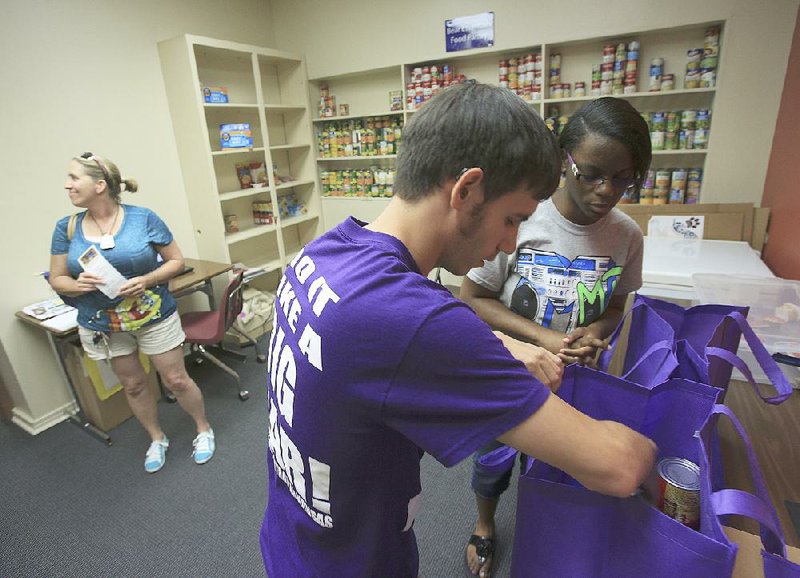Jennifer Yancey knew what she was doing when she gave up her 27-year nursing career and went back to school to get a teaching degree.
RELATED ARTICLE
http://www.arkansas…">Food pantries available at 8 state schools
Four years. No income. She was supporting her parents, her husband and her daughter, as well as herself.
Despite all that, she was taking care of her health.
"The circumstances were not spectacular at the time," she said. "It was stress, and the pressure was crazy, insane. But I'm much healthier now than I was then. And at least I'll be doing something that I enjoy."
Yancey, 51, had visited food banks in Conway County when she could, but with her school scheduling, it became harder and harder for her to drop in, the University of Central Arkansas student said.
That's when she tried out the campus food pantry, Bear Essentials.
UCA in Conway is one of many campuses in the state that have pantries for students, faculty and staff members. Food pantries are arms of food banks, distributing staples such as rice or pasta to those who need it. They all have different requirements such as proof of residency, proof of income or just an identification card.
The number of pantries at colleges and universities -- usually in storage rooms, classrooms or kitchens -- has increased nationwide in the past few years as campuses seek to add more student support services.
Those types of services are aimed at tackling potential barriers and helping students progress toward graduation.
For Yancey, one of the bigger obstacles was getting food. She had completed her core classes at the University of Arkansas Community College at Morrilton, but that campus didn't have a pantry.
"You just do what you have to do," Yancey said, adding that she had gotten help from her church before. "You have to take care of the absolute things that you need, and food is an absolute thing. It's hard to do your schoolwork when you're hungry. It's hard to concentrate on getting your things done ... for school when you're worried about paying the bills and feeding your family."
As of Thursday, more than 250 higher-education institutions were listed as members of the College and University Food Bank Alliance. Officials at Michigan State University's Student Food Bank and the Oregon State University Food Pantry co-founded the alliance, which helps support campus food banks. The two campuses were among the first to start the service.
In Arkansas, the University of Arkansas at Fayetteville was the first to open what's now the Jane B. Gearhart Full Circle Campus Food Pantry. The pantry is named after the last chancellor's wife, who was a champion of the movement and found a home on the campus for it, said Claire Allison, program coordinator for UA's Center for Community Engagement.
The pantry in Fayetteville got its start in February 2011 after students heard about struggling peers taking food from the dining hall to eat during the weekend, and students who were homeless and staying on other people's couches.
Among those struggling was Brandon Mathews, who used UA's pantry and worked there his senior year.
Mathews seemed to have all his ducks in a row -- until his employer, the now defunct video-rental store Blockbuster, began cutting back his hours. All of a sudden, he was finding it harder to make ends meet.
He talked to his mentor about his options. She asked if he had looked at applying for food stamps.
The Supplemental Nutrition Assistance Program is overseen by the U.S. Department of Agriculture. The eligibility requirements make it tough for college students to take part in the program.
There is some leeway, though, for students who are taking care of children or working at least 20 hours a week.
After learning he didn't qualify for the federal program, Mathews' mentor pointed him to the fledgling UA food pantry. Mathews didn't warm to the idea right away. There was fear. His feelings of self-worth bottomed out. He felt there was a stigma.
He lived with a roommate whose parents owned their condo. He compared his food supplies with his roommate's -- and their dinners. Mathews' staples were rice, a spoonful of peanut butter and -- if he had milk -- a bowl of cereal. He couldn't go out to eat with friends. He couldn't join friends for meals at the student union. Things like $2 soft drinks were a luxury. (The money could be spent on milk.)
But he weighed his options.
"If you don't have the food, you cut the budget there first," he said. "I can buy less food, cheaper food. You either degrade the quality of the food or eat so little food that you develop health problems. You're eating food that can lead to hypertension or health issues down the road. If you're having to navigate that with children, then you've got to worry about feeding them. You sacrifice yourself to make sure their need is met. Everything just builds and magnifies."
His only other thought? Taking out a loan. But that wasn't feasible.
So, he turned to the campus pantry.
Yancey's experiences didn't have as much of an emotional toll for her.
About a decade or so ago, she knew a single mother with two girls, she said. When the mom left the house, the girls confided to Yancey that they were hungry and didn't have food.
Yancey would go to the grocery store and pick up other staples from food banks, and, she said, that's how they ate.
Still, there are times when she, too, feels embarrassed.
The Morrilton resident said some people line up outside a Conway County food pantry in the middle of the night just to get food in the morning. Nearly a quarter of the 21,000 people who live in Conway County have incomes below the poverty level, according to U.S. Census data.
"If you think about it, you're used to living your life, paying your bills, buying your groceries and not having to ask for help," Yancey said. "And when you go from that -- and you're all for helping people when they need help -- but when you have to be the one that needs the help, that becomes a humbling experience. Sometimes, it's hard."
She poked her head into the food pantry at UCA just before Thanksgiving in 2014, and she said a great experience there had her returning. She wound up going every two to three weeks, she said.
There are no statewide or national statistics on students like Mathews and Yancey.
Studies from the U.S. Department of Agriculture and the hunger-fighting organization Feeding America offer some insights.
The state ranked second from the bottom in the number of residents, 19.9 percent, considered to lack enough nutritious food, according to the federal department's average for 2012 through 2014. Mississippi had the lowest number with 22 percent of its population lacking adequate and sufficient food.
Feeding America studies suggest that 1 in 10 of the adults they served were college students, and that 31 percent of its 46 million clients had to choose between paying for education or food each year.
Some colleges and universities survey their students before organizing campus food pantries. UA and the University of Arkansas at Pine Bluff found that 35 percent and 77 percent of their respective students didn't have adequate access to nutritious food.
"There's a lot of research on childhood hunger, and it's growing on senior hunger," said Allison with UA. "But the 18-to-24 age group hasn't been studied a lot. More and more, we're finding students don't have that support from home, and college has been getting more and more expensive every year."
Tuition at universities has been found typically to increase between 3 percent and 5 percent each year, while tuition increases at community colleges fluctuate more, depending on factors such as enrollment. Higher-education leaders are trying to find ways to keep the cost of attendance in check.
Also, the schools now are seeing an increase in nontraditional students.
Pulaski Technical College, for example, has many students who are single mothers, said spokesman Tracy Courage. The average age of the students at the North Little Rock-based college is about 30. To the surprise of Michelle Anderson, the director of student life and leadership at Pulaski Tech, nearly half of the campus's food pantry users had at least one person in the household working.
The momentum for further research and social services is growing.
In October, UA hosted a training program for college and university campuses that already had or were organizing pantries. The plan is for the colleges to draw together to address hunger on campus. The Fayetteville university also is hosting a national conference on food waste and hunger in April.
The Arkansas FoodBank also announced recently a $50,000 grant from the Carl B. and Florence E. King Foundation that will help create six campus pantries. The Arkansas FoodBank, which works with Pulaski Tech and UAPB, will work to open two new college pantries by this fall and another four in 2017, according to a news release.
Yancey has learned a lot in her use of the campus and area food pantries.
She gets creative with meals, like ground beef, cheese and rice. She saves everything. If she cooks chicken, for example, she makes broth first and stores what she doesn't use in her freezer. She's had chicken broth as a meal before, she said.
Leftovers are key, too.
And even if Yancey doesn't need something she gets at a pantry, she'll store it for later use. That's how she managed during the fall semester.
She's had some peace of mind knowing that the spring semester is her last and she'll earn a degree and teaching certification.
"It's a shame that we have to have more food pantries in order for people to survive," she said. "But there's no reason for somebody to have to do that, to go hungry."
Metro on 01/17/2016

